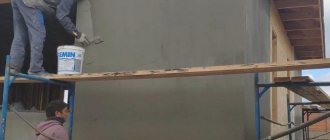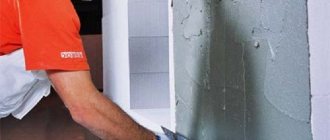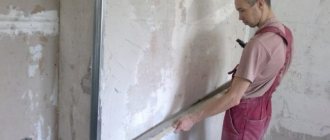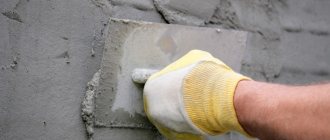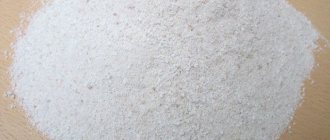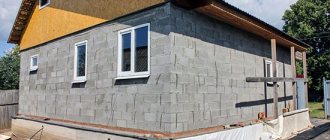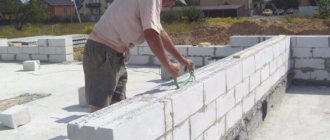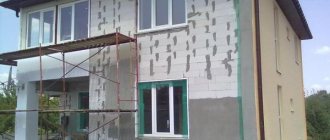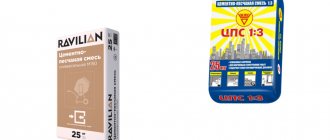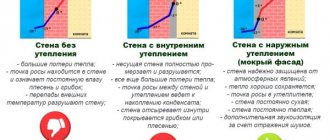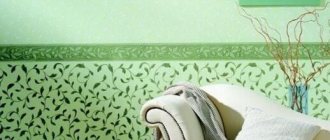11715 0 11
Michel November 27, 2016Specialization: plumber with 10 years of experience, computer repair specialist, powerlifting coach. I have extensive experience in construction, interior decoration, and making homemade furniture. Hobbies: sports
In this article we are going to find out what the difference is between plaster and wall putty. We will learn what each type of building mixture is used for and how their composition differs. We will also figure out how to putty and plaster correctly.
Plastering implies a rough basic finish, puttying - pre-finishing.
Plastering on concrete walls
Despite the fact that concrete has a relatively smooth surface, in the vast majority of cases it is not possible to immediately apply decorative finishing. This is hampered by the curvature of the walls themselves; they are often piled up vertically or run in waves. You can level the surface and make it suitable for wallpapering or painting using plaster. The technology for applying the solution to this base will have several features.
Puttying walls without prior plastering has a number of advantages:
- saving building materials that are not spent on plastering;
- saving time;
- reduction of labor intensity of work;
- reduction of financial costs;
- improving the permeability of walls to water vapor, which increases the comfort of the indoor microclimate without the use of forced ventilation.
There are also known disadvantages of the described technology, which boil down to applying 2-3 layers of putty in the case of maximum permissible differences in wall surfaces. The complexity and time of finishing work increases accordingly. Another nuisance may be the appearance of traces of gas block joints on a fully finished wall. Moreover, according to the “law of maximum meanness”, this will happen within a short time after the object is handed over to the customer.
Advice: Prevent the occurrence of such a defect by carefully monitoring the sealing of the seams between the masonry elements. The seam is filled without gaps or voids. Such control is necessary before completing finishing work.
Why do you need putty under wallpaper?
Remember what wallpaper used to be like? Paper, with edges that had to be cut off on one side and overlapped. This made it possible not to worry too much about the smoothness of the base; most often, the walls were covered with old newspapers before the final finishing.
Today, old newspapers have already been abandoned, but the unevenness of the walls still requires some tinkering to get the wallpaper to fit as it should. That is why many people prefer to immediately entrust these chores to third-party craftsmen who will do it faster, without unnecessary nerves and with high quality.
Modern wallpaper is glued end to end. And the slightest hole or protrusion at the junction of adjacent canvases leads to a poor-quality seam. Ideally, it should be completely invisible, which is why the base needs to be carefully leveled. But the role of putty is not only this.
Functions of putty
In addition to the final leveling of walls or ceilings, finishing putty allows you to solve other problems, which include:
- Elimination of defects such as cracks, chips, large scratches, etc.;
- Giving the base greater strength;
- Increasing the adhesive properties of the base - its ability to firmly adhere to the finishing coating;
Note. Primer compounds fully possess this property, and in some cases it is enough to use only them if other qualities of the putty are not relevant in your case.
- Reducing the ability of the wall material to absorb moisture. This is important for high-quality wallpaper stickers and allows you to save glue;
- Leveling the surface color. White putty will reliably protect the wallpaper (see Decorating walls with wallpaper in the correct form) from stains that can show through it from an untreated wall.
As you can see, putty has many functions, and any of them can play a decisive role in the quality of the finish.
Putty of different materials
Now let's figure out whether putty is always needed and how it depends on the base material:
- Brick walls definitely need leveling. If the masonry is fairly smooth, you can do without plaster, using several layers of starting coarse putty, and finishing the preliminary finishing with a thin finishing layer.
How long does it take for plaster to dry, how to work with putty and other nuances
The drying rate for most current types of plaster (with the exception of gypsum) can be determined using a simple formula: 1 mm of layer dries in one day. So, a layer of 5 mm will dry in five days. Gypsum plaster is considered the fastest drying plaster. Its thickest layer will dry in a maximum of four days.
An important factor influencing the drying speed will be the maximum thickness of the applied layer. The drying speed of layers thicker than 5 centimeters is noticeably reduced.
One layer of plaster 1 mm dries in 1 day
In conclusion, we will give some nuances regarding the choice of putty and working with it.
- Materials such as gypsum and alabaster are difficult to process and shape. They compensate for this disadvantage with a high drying speed (up to 15 minutes). Satengypsum is a more elastic material, but it takes much longer to dry.
- Dry putties have one significant drawback - when humidity increases, they soften again. To prevent this from happening, it is better to use moisture-resistant compounds when finishing.
- When priming walls in rooms with high humidity, be sure to treat the surfaces with waterproofing primers. It is recommended to apply two layers.
- You can determine the readiness of the putty by its consistency. It should not clump or run off the spatula blade. An elastic composition that slightly adheres to the surface of the spatula will be optimal.
It is better to mix the putty in small batches - It is better to mix the putty in small portions so that dry particles do not have time to form in its mass, which can impair the quality of work. It is best to prepare the mixture using a drill with a screw attachment. But you can do this manually. Under no circumstances violate the kneading technology recommended by the manufacturer. This may negatively affect the consistency of the mixture and, as a result, the finishing result.
- The remaining strips from the spatula can be leveled with the final layer.
Installation of beacons
How smooth the surface you get will depend on the correct installation of the beacons. They are:
- Plaster. In this case, gypsum mortar is applied to the wall in equal fragments, so that the height of the beacons corresponds to the thickness of the plaster. The advantage of plaster is that it dries quickly.
- Cement-sand. Such landmarks are made in the same way as plaster ones. Cement mortar is cheaper, but such beacons can only be installed in small rooms.
- Wooden slats. Vertical lathing made of wooden slats is suitable for apartments, however, landmarks of this type quickly swell from moisture, making it impossible to obtain a flat surface.
- Metal slats. This profile is considered the most reliable. Its main advantage is that the beacons do not have to be removed.
To install beacons follow these steps:
- Screw the self-tapping screw under the ceiling (at a distance of about 150 mm from the corner). The thickness for plaster is determined by the distance from the screw head to the wall.
- Install the same self-tapping screw on the floor (it should be screwed in in a vertical straight line from the “ceiling”).
- Place lumps of plaster between the two screws, the height of which should be slightly greater than the guides.
- Attach the metal profile to the screws, slightly deepening it into the solution. At the same time, make sure that the rail is laid evenly; for this, use a building level. If a deviation occurs, the screws must be adjusted until the metal guide is strictly vertical.
- Install the rail on the opposite side of the wall in the same way.
- Stretch the thread between the beacons and, using it as a guide, install the remaining guides. The step between the slats should not exceed the width of the rule.
Preparation
Cement and gypsum mixtures are prepared differently. The cement mixture can be mixed with water in any way - pour water into it or pour the contents of the bag into the water. When mixed with a mixer or a drill with a whisk, the solution is homogeneous and without lumps.
To prepare your own plaster, you need to mix the ingredients and add water to them.
In the case of a gypsum mixture, the procedure must be strictly defined:
- Water is poured into a wide container (usually at the rate of 1 liter per 1.6 kg of dry mixture);
- Plaster or putty is poured into the water. At the same time, it is distributed as evenly as possible over the surface of the water surface;
The dry gypsum mixture is poured into water. If you pour water into the mixture, you may end up with dry, insoluble lumps at the bottom of the container.
- After a five-minute pause (during this time the mixture will absorb water), the contents of the container are mixed.
Mixing gypsum putty with a drill and whisk.
Plastering and puttying walls with gypsum mixtures requires preparing portions of different sizes. When plastering, you can prepare up to 10 liters at a time, but when puttying - no more than 2-3 liters. Putty is consumed more slowly, and you risk not using it up during the life of the solution.
The putty must be mixed in small portions.
We open the walls with finishing putty.
The finishing putty solution does not contain large fractions and when finished has the consistency of sour cream. The finished layer is smooth, very dense and does not absorb paint.
The method of applying the finishing putty is similar to the starting putty. The only difference is the thickness of the layer: for finishing putty it should be 1.5-2 mm. This thickness helps to obtain a smooth surface without bumps or dents, which is ideal for painting. However, preparing walls for painting involves sanding a layer of finishing putty. Use an abrasive mesh with a grain size of 60-80 to achieve the effect of a “glass” surface and not inadvertently remove the entire previously applied layer.
If applying one layer of solution does not give the desired result, you can apply finishing putty in several layers. Check the quality of the work with a spotlight or lamp. Direct the light source so that it falls at an oblique angle to see all the imperfections. Puttying walls before painting with your own hands means eliminating all irregularities, otherwise they will appear after painting the walls.
Video description
The video will show what kind of putty or plaster there is and what is the difference between them:
Types of putty mixtures:
- Oil – used to protect the surface from excessive moisture. Consists of drying oil, driers and chalk.
- Adhesive – characterized by increased adhesion. It contains the same drying oil and chalk. Glue is also added.
- Oil-adhesive – prepares the surface for painting or wallpapering.
- Gypsum is considered the most environmentally friendly.
- Epoxy – perfectly protects against most chemical aggressions.
- Polyester – used for restoration of metal after corrosion damage.
- Latex - for sealing drywall seams.
- Putty – levels plastered surfaces.
- Acrylic universal - suitable for literally any surface. Often used to repair plaster.
- Acrylic façade – resistant to moisture and ultraviolet radiation. Good abrasion resistance.
- Based on PVA - for sealing cracks and joints.
Plaster or putty reliably protects the surface from moisture and perfectly eliminates various defects. Only the thickness of the overlay is different. The minimum layer of plaster is 10 mm. And the maximum thickness of the putty is only 1 mm.
Distribution of putty over the surface Source mirbetona.info
Is it necessary to putty on walls plastered with cement mortar in front of the wallpaper?
Despite the enormous popularity of gypsum mixtures, plaster based on sand and cement remains in demand. We often see walls perfectly plastered along lighthouses with sand and cement mortar.
The whole problem is the flowability of the material. Even perfectly balanced plaster can crumble a little after drying. Therefore, you need to purchase a deep penetration primer for interior and exterior use. Prime the walls liberally until they stop absorbing it. After drying, the primer will strengthen the walls and they will not crumble.
Note! Not all types of wallpaper can be glued in this case. On walls plastered with sand-cement mortar, you can glue wallpaper made of dense material and with a large texture. Do not glue thin wallpaper, wallpaper without a textured pattern (smooth). If the sun's rays pass parallel to the wall during the day, imperfections are bound to appear. Small bumps may appear on the wallpaper from large grains of sand under the wallpaper. At certain angles, sunlight will create highlights similar to pimples. Believe me, despite the high cost and beauty of the wallpaper, a pimply wall will look terrible.
Since sand and cement plaster crumbles from the lighthouses, they can be visible under thin wallpaper. There will be no problems with dense, textured wallpaper.
What you need to create a simulation
Among the materials that will need to be purchased for successful decoration are:
- primer;
- masking tape;
- paint;
- plaster;
- putty;
- varnish
In addition to materials, you need to buy tools. Among the devices that will definitely be needed during repairs are:
- putty knife;
- paint roller;
- tape measure and pencil;
- bucket for mixing the solution;
- paint container;
- stationery knife.
The method of simulating brick decor determines what materials and tools will be needed. If additional devices are required during the repair, they can always be purchased. It is recommended to first provide yourself with the essentials.
What is the best way to putty the walls? Tools
To putty the walls we will need:
- A trowel for applying the finished mortar to the wall.
- Spatulas (Large, medium (small)).
- Rubber spatula (very small).
Catalog of tools for finishing work
If you rarely go to hardware stores, then it may be difficult for you to immediately navigate which department and what you need to take. Here is a catalog of tools for finishing work, where you can safely search for everything you need for work: construction buckets, spatulas, trowels, trowels, etc.
And below we will look at the most interesting thing - this is the process of puttying walls.
Wooden panel
The panel instantly transforms the interior. You can simply hang it on the wall of your choice, like a painting. The product zones the space; it can be used as a headboard or a decorative accent. Make a board panel of the appropriate size, cover it with stain or oil and fix it. Old wooden boards with defects look best. Another option is to make a panel out of cork or plywood and then decorate it with photographs.
Mesh for plastering works
Mesh for plaster is used when there is no confidence in its strength, and when the thickness of the plaster is more than two centimeters. Experts recommend that the cells on the plaster mesh should not be larger than 5x5 mm.
Using the mesh, a frame is created that holds the plaster on the concrete. This is important in areas where damage and high humidity are possible.
conclusions
Considering the huge selection of putty material for working on concrete, we advise you to pay attention first of all to two parameters - its price and instructions for use. The price may differ several times and not only due to different volumes of packages (see also the article “Plastering walls made of aerated concrete: technology features and materials used”).
The instructions may provide for various nuances of use (like the one presented, which does not require a primer and allows only +3 in the air).
Be sure to watch the video in this article and collect a database of your possible choices.
Technology for gluing wallpaper on concrete
Wallpapering concrete walls involves certain rules and stages of work. It is advisable to follow them so that the result pleases with beauty and durability.
Tool
In order to hang wallpaper so that it does not come off in the future, you need to stock up on a set of necessary tools.
What you will need for work:
- Paint roller and special tray
- Rubber roller
- Paint brush
- Sharp utility knife
- Building level
- Simple pencil and tape measure
- Clean rags
Preparation
First, the surface of the wall is thoroughly cleaned of dirt, dust and anything that could impair the adhesion of materials. Then the walls are covered with a layer of primer - usually they use wallpaper glue diluted with water or choose a special primer (acrylic is very popular, which does not have an unpleasant odor, demonstrates excellent characteristics, and is affordable).
How to perform priming:
- Shaking the container with primer.
- Pouring liquid into a tray (or any flat container) to make it comfortable to dip the roller.
- Wetting the roller in the primer, lightly squeezing it to ensure even distribution of the composition on the tool and the wall.
- Uniform surface treatment from top to bottom. It is advisable to apply the composition in an even thin layer, avoiding accumulation of the substance in certain areas and drips.
- Drying of the composition, re-application of primer.
Before starting priming, it is advisable to lay all communications that may require drilling holes, gating channels and other work, during which it is necessary to damage concrete and reinforced concrete structures, violating their integrity.
Preparation of materials
Before you stick wallpaper on a concrete wall to prevent it from peeling off, you need to properly prepare the materials. First, carefully measure the height of the walls, mark and cut the canvas into pieces according to the measurements.
Types of materials
Plaster and putty are so popular among builders that they began to divide each one according to its purpose. From here came many types of solutions that are used to achieve certain goals.
Types of decorative plaster mixtures:
- Colored - ideal for interior decoration.
- Stone - creates an imitation of natural stone.
- Venetian - resembles marble.
- Sgraffito - consists of two or more layers and is similar to painting.
- Terrasite - a multi-component composition creates a beautiful rough surface.
- Silk - the so-called liquid wallpaper.
In addition to the most common lime, gypsum and cement-sand mortars, you can also find special mixtures. For example, magnesium plaster is intended for interior work, when it is necessary to ensure high non-combustibility of the object.

